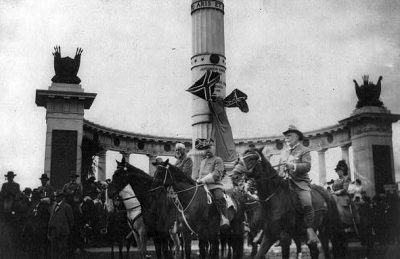Monumental moments
05 September 2017 – James F. Brooks

George Washington Custis Lee, on horseback, with staff in Richmond, Virgina, at the unveiling of a monument to Jefferson Davis, in June 1907. Photo credit: Library of Congress, Reproduction Number: LC-USZ62-58277. Photograph by Edyth Carter Beveridge.
On Monday, August 14, roped and yanked from its pedestal by people angered by the violence that unfolded the preceding night in Charlottesville, Virginia, a statue commemorating “THE BOYS WHO WORE THE GRAY” lay crumpled on the lawn before the old courthouse in Durham, North Carolina. We saw many more statues and monuments defaced, removed, or relocated in the weeks that followed, as citizens and politicians seized the moment to debate what some saw as commemoration of the heroism of Confederate soldiers during the Civil War. Others argued these monuments served as enduring nostalgia for the “Lost Cause,” while many pointed out the timing of their establishment (like that of the 1907 Richmond, Virginia memorial to Jefferson Davis on our cover) to evidence their purpose as not-so-subtle endorsements for the eras of slavery and white supremacy in the New South. While dozens of historians stepped forward to contextualize the timing and intent of these memorials and endorse their removal, in the weeks that followed many Americans agreed with President Donald J. Trump that it was “Sad to see the history and culture of our great country being ripped apart with the removal of our beautiful statues and monuments . . . you can’t change history, but you can learn from it.”
Seizing the final clause in the president’s message as our license, we at The Public Historian take this opportunity to share a dozen essays from the journal’s backlist, ranging across some twenty years, that illustrate the evolving historiography on the issue of monuments, memory, history, and heritage and broaden the discussion beyond the focus of the Civil War, Redemption, and resistance to the expansion of civil rights during the 1960s and 1970s. We lead this special virtual issue, “Monuments, Memory, Politics, and Our Publics,” with an OpEd authored by recent TPH assistant reviews editor and doctoral candidate Cheryl Jimenez Frei. She suggests we consider the model of Argentina’s Comisión Nacional sobre la Desaparición de Personas (National Commission on the Disappeared, 1983–84) as something “good to think with” about our own dilemmas: “Argentina became a nation obsessed with memory, at the forefront of struggles to confront and account for a painful past.” The essays that follow range from the colonial era to World War II, from Czechoslovakia to Germany, and encompass attempts to redress episodes in Native American, Japanese, and Holocaust history in addition to the specific issue of the United States’ experience with slavery and racial injustice. Overall, we see this collection as offering deeper understanding and empathy for the full range of responses across the public sphere in recent weeks, as well as ideas for discussing the issues and developing them in your classrooms.
We thank our publisher, the University of California Press, for bringing this special issue to “print” so quickly and allowing free access through the end of November.
~ James F. Brooks is editor of The Public Historian and professor of history and anthropology at the University of California, Santa Barbara.



